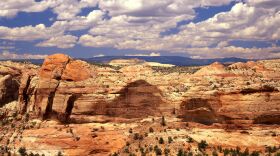When President Trump shrank the size of two national monuments in Utah, it left many hundreds of scientifically valuable fossil sites outside the new boundaries. Paleontologists are worried about their fate. KNAU’s Melissa Sevigny reports.
Grand Staircase-Escalante and Bears Ears were both established as national monuments partly to protect fossils. The two areas preserve significant sequences in Earth’s history, including the time of the dinosaurs.


David Polly, president of the Society of Vertebrate Paleontology, says, "They’re very rich and very complete sequences, that’s why they were set aside, and taking parts of them out of the monuments is essentially like ripping pages out of that history."
Polly says the fossils still have some protection under federal law, but because they’re no longer on monument land, they could be destroyed by activities like mining or grazing.
The change also jeopardizes funding for scientific work. Paleontologist Rob Gay was excavating a Triassic site of crocodile-like creatures in Bears Ears last year when the monument boundaries shifted and invalidated his grant money. He says, "So we’re still researching the fossils that are out of the ground...but for the fossils still in the ground, it’s sort of in limbo."
The Society of Vertebrate Paleontology and other groups have sued the Trump Administration to try to reinstate the original monument boundaries.
The Bureau of Land Management did not respond to KNAU’s request for comment.







